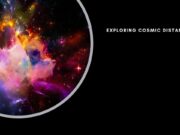The Basics of Parallax: Measuring Our Solar System
🌍 Parallax: A Geometric Approach
Unveiling the Universe: How Scientists Measure Cosmic Distances:
Parallax is one of the fundamental methods used by astronomers to measure distances to nearby celestial objects. This technique relies on basic geometry. By observing the apparent movement of an object against a distant background from two different positions, astronomers can calculate its distance. This method is particularly effective within our solar system.
When you observe a nearby object, such as a tree, from two different spots a few meters apart, you notice a shift in its position relative to distant objects, like mountains. This shift is known as parallax. Astronomers apply the same principle to measure the distances to planets and asteroids. By taking measurements from opposite sides of Earth’s orbit around the Sun, they can triangulate the distances to these nearby objects with remarkable precision.
Reaching for the Stars: Cepheid Variable Stars
🌟 Cepheid Variable Stars: Cosmic Standard Candles
To measure distances beyond our solar system, astronomers turn to Cepheid variable stars. These stars are unique because their brightness varies in a predictable pattern over time. The period of their brightness variations is directly related to their intrinsic luminosity, a relationship known as the period-luminosity relation.
By observing the pulsation period of a Cepheid variable star, astronomers can determine its true brightness. Comparing this intrinsic brightness to its apparent brightness from Earth allows them to calculate the distance to the star. Cepheids have become essential tools for measuring distances to galaxies within our local group and slightly beyond.
Expanding Horizons: The Role of Supernovae
🚀 Supernovae: Measuring the Vast Distances
While Cepheid variable stars help measure distances within a few million light-years, astronomers needed a more powerful tool to probe deeper into the universe. Enter Type Ia supernovae, stellar explosions that occur in binary systems when a white dwarf accretes enough material from its companion star to trigger a catastrophic detonation.
Type Ia supernovae serve as standard candles because their peak brightness is remarkably consistent across different explosions. By comparing the observed brightness of a supernova to its known intrinsic brightness, astronomers can measure distances to galaxies halfway across the visible universe. This method has been pivotal in exploring the vast cosmic scales and has led to significant discoveries about the universe’s nature.
Discovering the Expanding Universe
🌌 Redshift and the Expanding Universe
One of the most profound discoveries in astronomy is the realization that the universe is expanding. This revelation came from observing the redshift of light from distant galaxies. As a galaxy moves away from us, the light it emits is stretched to longer, redder wavelengths. The farther away a galaxy is, the faster it appears to be moving away, a relationship known as Hubble’s Law.
This observation led to the groundbreaking conclusion that the universe is not static but expanding. Moreover, the discovery that distant galaxies are accelerating away from us suggests that an unknown force, dubbed dark energy, is driving this acceleration. This has transformed our understanding of the cosmos and opened new frontiers in cosmology.
Transforming Our Understanding of the Universe
💡 From Local Measurements to Cosmic Insights
The development of these distance measurement techniques has revolutionized our perception of the universe. By starting with the relatively simple method of parallax within our solar system and advancing to the sophisticated use of standard candles like Cepheid variables and supernovae, astronomers have unveiled the universe’s vastness, its dynamic nature, and the forces shaping its evolution.
These insights have profound implications, not just for our understanding of space, but for the fundamental laws of physics and the ultimate fate of the cosmos. As we continue to refine our measurement techniques and explore further into the universe, we can expect to uncover even more astonishing revelations about the nature of reality itself.





























